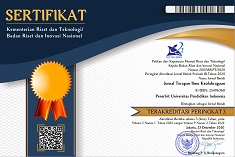Pengaruh Olahraga Jalan Kaki Terhadap Antisipasi Reaksi Pada Lansia
Abstract
Abstrak
_________________________________________________________
Mengingat pentingnya konektivitas kondisi istirahat sebagai parameter fungsi otak. sejauh ini belum ada ulasan yang mencoba mengukur manfaat kesehatan yang lebih luas dari kelompok berjalan dibandingkan dengan kelompok yang tidak aktif terhadap antisipasi reaksi. Oleh karena itu, ulasan ini dilakukan untuk memahami apakah ada bukti bahwa kelompok berjalan memiliki manfaat yang lebih besar bagi kelompok lansia. Desain dalam penitian ini menggunakan ekperiment dengan pendekatan ex post pacto. Subjek berjumlah 33 lansia dengan usia rata-rata (62.1 ± 2.1 tahun), tinggi (152 ± 2.1 cm), berat badan (53.4 ± 5.7 kg), BMI (23.1 ± 2.5 %). Hasil penelitian menunjukan bahwa olahraga jalan kaki memiliki skor antisipasi reaksi yang lebih tinggi (101.4 ± 12.9) dibandingkan dengan yang tidak aktif melakukan aktivitas fisik (84.7 ± 16.3). usia lansia diharapkan selalu meningkatkan latihan fisik (aktivitas fisik), seperti jalan kaki, sehingga kemampuan antisipasi reaksi dapat dihambat penurunannya.
Abstract
_________________________________________________________
Considering the importance of connectivity resting conditions as parameters of brain function. so far there have been no reviews that try to measure the broader health benefits of the walking group compared to those who are not active in anticipating reactions. Therefore, this review is carried out to understand whether there is evidence that the walking group has greater benefits for the elderly group. The design in this research used an experiment with an ex post pacto approach. There were 33 subjects with an average age (62.1 ± 2.1 years), height (152 ± 2.1 cm), weight (53.4 ± 5.7 kg), BMI (23.1 ± 2.5%). The results showed that walking had a higher anticipation reaction score (101.4 ± 12.9) compared to those who were not actively doing physical activity (84.7 ± 16.3). Elderly age is expected to always increase physical exercise (physical activity), such as walking, so that the ability to anticipate reactions can be inhibited.
Keywords
Full Text:
PDFReferences
Bhammar, D. M., Sawyer, B. J., Tucker, W. J., & Gaesser, G. A. (2017). Breaks in sitting time: Effects on continuously monitored glucose and blood pressure. In Medicine and Science in Sports and Exercise (Vol. 49). https://doi.org/10.1249/MSS.0000000000001315
Erickson, K. I., Leckie, R. L., & Andrea M. Weinstein. (2014). Physical activity, fitness, and gray matter volume. Bone, 23(1), 1–7. https://doi.org/10.1038/jid.2014.371
Farrell, L., Hollingsworth, B., Propper, C., & Shields, M. A. (2014). The socioeconomic gradient in physical inactivity: Evidence from one million adults in England. Social Science and Medicine, 123, 55–63. https://doi.org/10.1016/j.socscimed.2014.10.039
Gomeñuka, N. A., Oliveira, H. B., da Silva, E. S., Passos-Monteiro, E., da Rosa, R. G., Carvalho, A. R., … Peyré-Tartaruga, L. A. (2020). Nordic walking training in elderly, a randomized clinical trial. Part II: Biomechanical and metabolic adaptations. Sports Medicine - Open, 6(1), 1–19. https://doi.org/10.1186/s40798-019-0228-6
Hanson, S., & Jones, A. (2015). Is there evidence that walking groups have health benefits? A systematic review and meta-analysis. British Journal of Sports Medicine, 49(11), 710–715. https://doi.org/10.1136/bjsports-2014-094157
Jekel, K., Damian, M., Wattmo, C., Hausner, L., Bullock, R., Connelly, P. J., … Frölich, L. (2015). Mild cognitive impairment and deficits in instrumental activities of daily living: A systematic review. Alzheimer’s Research and Therapy, 7(1). https://doi.org/10.1186/s13195-015-0099-0
Jones, K. D. (2015). Recommendations for resistance training in patients with fibromyalgia. Arthritis Research and Therapy, 17(1), 10–11. https://doi.org/10.1186/s13075-015-0782-3
Kassavou, A., Turner, A., & French, D. P. (2013). Do interventions to promote walking in groups increase physical activity? A meta-analysis. International Journal of Behavioral Nutrition and Physical Activity, 10(1), 1. https://doi.org/10.1186/1479-5868-10-18
Kivipelto, M., Mangialasche, F., & Ngandu, T. (2018). Lifestyle interventions to prevent cognitive impairment, dementia and Alzheimer disease. Nature Reviews Neurology, 14(11), 653–666. https://doi.org/10.1038/s41582-018-0070-3
Lisa O’Keefe. (2017). Active Lives Survey 2015-16. Sport England, 16, 1–18.
Milton, K., & Bauman, A. (2015). A critical analysis of the cycles of physical activity policy in England. International Journal of Behavioral Nutrition and Physical Activity, 12(1), 1–9. https://doi.org/10.1186/s12966-015-0169-5
Pavey, T. G., Taylor, A. H., Fox, K. R., Hillsdon, M., Anokye, N., Campbell, J. L., … Taylor, R. S. (2011). Effect of exercise referral schemes in primary care on physical activity and improving health outcomes: Systematic review and meta-analysis. BMJ (Online), 343(7831), 980. https://doi.org/10.1136/bmj.d6462
Reppermund, S., Brodaty, H., Crawford, J. D., Kochan, N. A., Draper, B., Slavin, M. J., … Sachdev, P. S. (2013). Impairment in instrumental activities of daily living with high cognitive demand is an early marker of mild cognitive impairment:The Sydney memory and ageing study. Psychological Medicine, 43(11), 2437–2445. https://doi.org/10.1017/S003329171200308X
Stoffers, D., Diaz, B. A., Chen, G., Den Braber, A., Van’t Ent, D., Boomsma, D. I., … Linkenkaer-Hansen, K. (2015). Resting-state fMRI functional connectivity is associated with sleepiness, imagery, and discontinuity of mind. PLoS ONE, 10(11), 1–18. https://doi.org/10.1371/journal.pone.0142014
Yang, Y., Chen, T., Shao, M., Yan, S., Yue, G. H., & Jiang, C. (2020). Effects of Tai
Chi Chuan on Inhibitory Control in Elderly Women: An fNIRS Study. Frontiers in Human Neuroscience, 13(January), 1–11. https://doi.org/10.3389/fnhum.2019.00476
Zou, L., Loprinzi, P. D., Yeung, A. S., Zeng, N., & Huang, T. (2019). The Beneficial Effects of Mind-Body Exercises for People With Mild Cognitive Impairment: a Systematic Review With Meta-analysis. Archives of Physical Medicine and Rehabilitation, 100(8), 1556–1573. https://doi.org/10.1016/j.apmr.2019.03.009
DOI: https://doi.org/10.17509/jtikor.v5i1.24381
Refbacks
- There are currently no refbacks.
Copyright (c) 2020 Lungit Wicaksono, Imam Safei

This work is licensed under a Creative Commons Attribution-NonCommercial-ShareAlike 4.0 International License.





